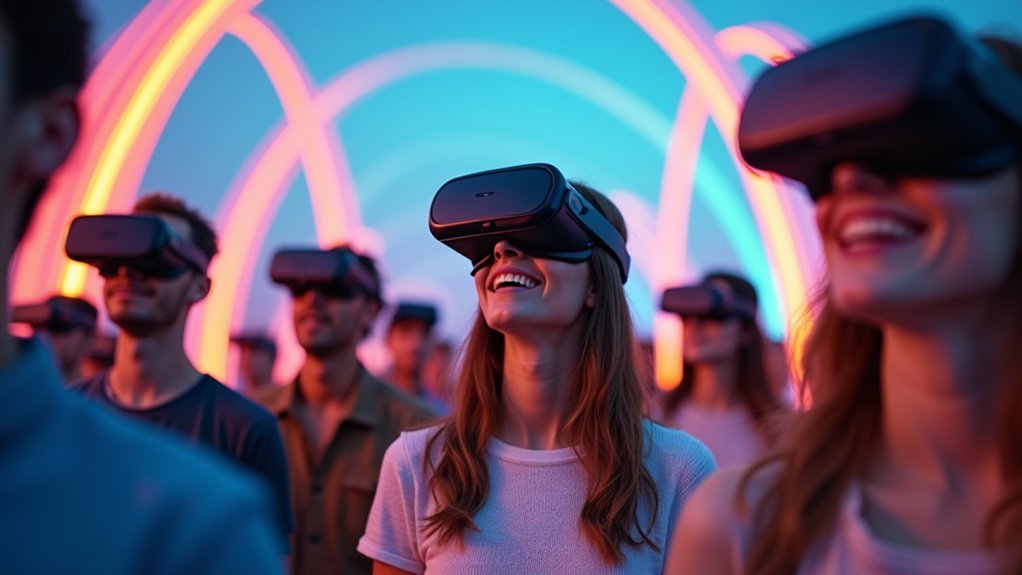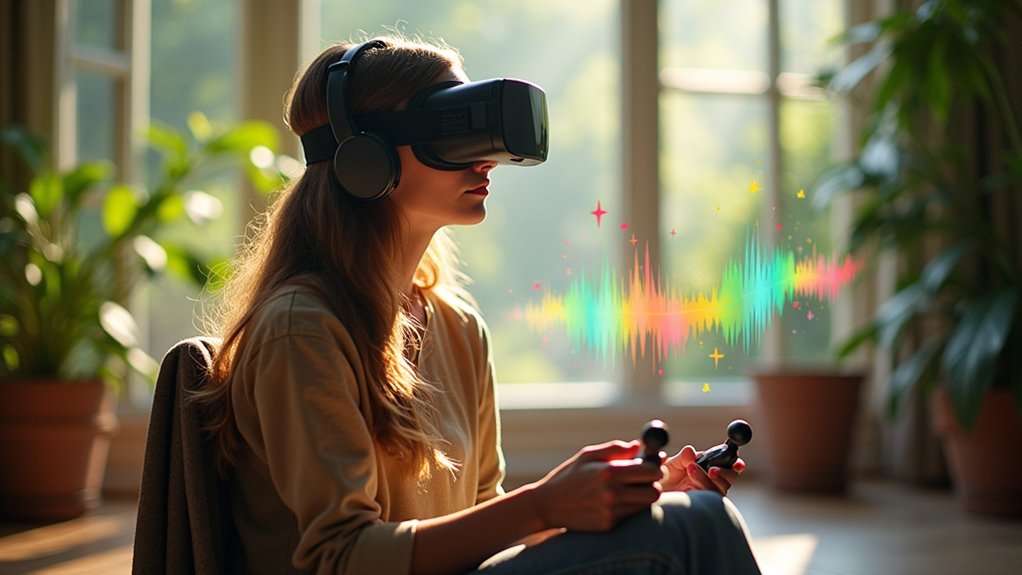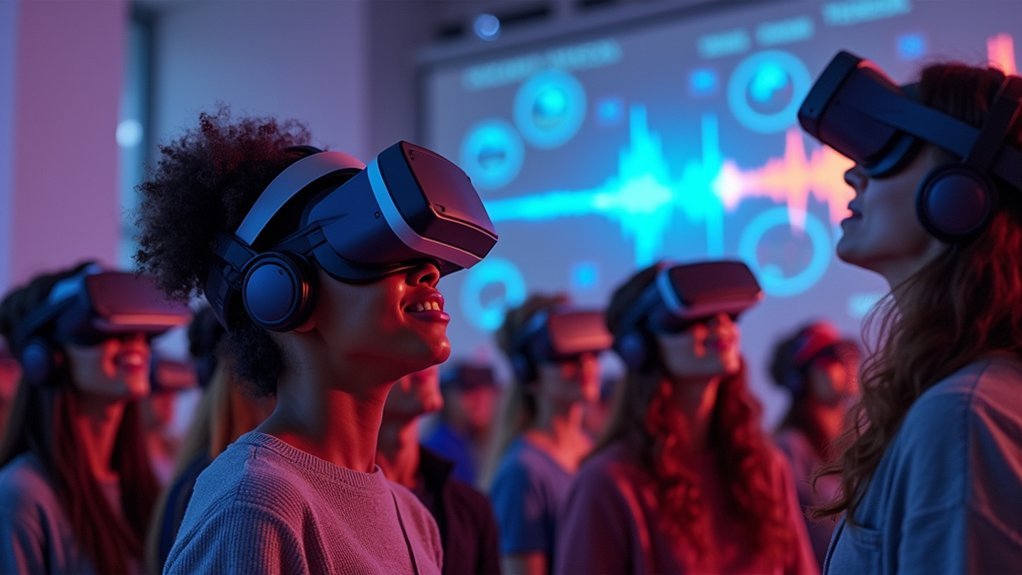Spatial audio makes VR more accessible by transforming virtual environments into inclusive experiences you can navigate through sound alone. You’ll receive directional audio cues that replace visual landmarks, helping you identify object locations and spatial orientation with precision. This technology adapts to your individual hearing needs while providing essential navigation support for users with disabilities. The three-dimensional soundscapes create thorough accessibility that breaks down barriers, and there’s much more to discover about this transformative approach.
How Spatial Audio Creates Inclusive Virtual Environments

When you enter a virtual reality environment equipped with spatial audio, you’re experiencing technology that fundamentally transforms how inclusive these digital spaces can be. This immersive audio experience provides essential auditory cues that help you navigate and interact with virtual environments, regardless of your visual abilities.
You’ll discover that realistic soundscapes enable precise object and character location identification, while customizable sound settings adapt to your specific hearing needs.
Spatial audio makes virtual environments truly accessible by creating emotional impact through sound-based interactions. You’ll find increased engagement as these auditory enhancements support diverse user requirements.
Spatial audio transforms virtual spaces into emotionally rich, engaging environments that welcome and support users of all abilities.
Whether you’re managing cognitive challenges or relying primarily on audio input, spatial audio guarantees you’re fully included in the virtual experience, fostering genuine inclusivity across all user populations.
Breaking Down Visual Barriers Through Directional Sound Cues
Directional sound cues transform how you perceive and interact with virtual spaces, particularly when visual information isn’t available or accessible.
Spatial audio creates engaging experiences by providing precise sound localization that guides navigation and interaction for users with visual impairments.
Here’s how directional sound cues break down barriers:
- Navigation Enhancement – You’ll receive auditory indicators of object locations and spatial orientation, eliminating dependency on visual elements for movement through virtual environments.
- Performance Improvement – Training with spatial audio systems boosts your real-world performance by 30% through enhanced situational awareness.
- Narrative Accessibility – You can follow storytelling through sound cues, making VR content accessible for users with cognitive disabilities.
- Multi-sensory Integration – Combined auditory and haptic feedback creates thorough accessibility solutions for diverse needs.
Enhanced Navigation for Users With Disabilities

Since spatial audio transforms virtual environments into navigable soundscapes, you’ll discover unprecedented independence when exploring VR worlds regardless of your visual abilities.
Enhanced navigation becomes possible through directional sound cues that guide your movement and interaction. When you’re a user with disabilities, particularly visual impairments, these audio signals replace traditional visual landmarks with acoustic ones.
Your spatial awareness improves dramatically as sounds indicate objects, boundaries, and pathways around you.
Adaptive spatial audio responds to your specific needs, creating an intuitive interface that reduces learning curves. You’ll navigate virtual environments with greater confidence, performing tasks that might otherwise seem impossible.
These accessible experiences guarantee you’re not excluded from VR’s potential, making technology truly inclusive for all users.
Universal Design Principles in VR Audio Implementation
Universal design principles in VR audio implementation create experiences that work for everyone from the start, rather than requiring retrofitted accessibility features.
When you’re designing spatial audio systems, you’re building inclusive foundations that enhance accessibility across all user groups.
Here’s how universal design principles transform VR audio implementation:
- Auditory cues align with visual elements, providing critical navigation context for users with visual impairments while enhancing everyone’s spatial awareness.
- Adaptive audio technologies automatically adjust soundscapes based on individual preferences, accommodating hearing impairments and frequency sensitivities.
- Clear directional sounds support cognitive accessibility by helping users with cognitive disabilities maintain orientation in complex virtual environments.
- Standardized audio formats guarantee compatibility across devices, ensuring all users can access immersive soundscapes regardless of hardware capabilities.
Real-World Impact on Accessibility Across Industries

As spatial audio technology moves beyond theoretical frameworks into practical applications, you’re witnessing its transformative impact across industries where accessibility matters most.
In educational applications, students with disabilities experience immersive experiences through engaging soundscapes that simplify complex concepts.
Healthcare applications deliver therapeutic benefits, creating tailored sound environments that reduce anxiety for patients with PTSD or autism.
Therapeutic spatial audio creates personalized soundscapes that significantly reduce anxiety levels in PTSD and autism patients.
Virtual reality (VR) gaming now provides enhanced situational awareness for players with hearing impairments, while spatial audio helps users with visual impairments navigate virtual environments through precise auditory cues.
This real-world impact extends across sectors, driving inclusive digital experiences that weren’t possible before.
The technology’s projected market growth at 20.3% CAGR through 2027 reflects industry-wide commitment to accessibility innovation.
Technical Solutions for Diverse User Needs
When developers implement spatial audio solutions in VR, they’re addressing the unique challenges that users with different abilities face in virtual environments.
These technical innovations create inclusive design opportunities that transform accessibility through sound.
Key spatial audio technologies enhancing VR accessibility include:
- Binaural audio and HRTFs – Enable precise audio localization, helping users identify direction and distance of sounds for better navigation.
- Real-time processing systems – Adapt aural cues dynamically to user interactions, supporting varying hearing abilities.
- Customizable soundscape tools – Allow developers to tailor immersive experiences for individual user needs.
- Affordable hardware integration – Makes high-quality spatial audio accessible without expensive setups.
You’ll find these solutions particularly effective because they provide essential orientation information through sound, making VR environments navigable for users who rely on auditory feedback rather than visual cues.
Expanding VR Adoption Through Audio Innovation
These technical advances in spatial audio create powerful ripple effects that extend far beyond individual accessibility improvements.
When you implement spatial audio in VR experiences, you’re not just enhancing accessibility for users with hearing impairments—you’re fundamentally transforming how engaging environments attract diverse audiences. This inclusive VR approach drives significant adoption rates across previously underserved communities.
Your investment in immersive audio technology delivers measurable returns. Research demonstrates 30% performance improvements in training simulations when spatial audio is integrated, making VR more compelling for educational and professional applications.
Spatial audio integration boosts VR training simulation performance by 30%, delivering compelling returns for educational and professional applications.
The market responds accordingly, with spatial audio technologies projected to grow 20.3% annually through 2027.
Tools like the MaaS Toolkit democratize these capabilities, enabling smaller developers to create accessible experiences without extensive resources, further accelerating widespread VR adoption.
Frequently Asked Questions
How to Make VR More Accessible?
You can make VR more accessible by implementing voice controls, adjustable text sizes, customizable interfaces, haptic feedback options, and multiple input methods that accommodate users with various physical and cognitive abilities.
Why Is Spatial Audio so Much Better?
Spatial audio creates realistic sound positioning that matches your head movements, making virtual environments feel natural. You’ll experience 30% better performance in training scenarios because your brain processes directional audio cues just like real life.
How Does VR Affect Spatial Awareness?
VR enhances your spatial awareness by providing immersive 3D environments where you practice navigation and object interaction. You’ll develop better mental mapping skills and improved understanding of spatial relationships through repeated virtual experiences.
Does Spatial Audio Help With Gaming?
You’ll experience greatly better gaming performance with spatial audio since it provides precise sound localization, helping you identify enemy positions and environmental cues more accurately, ultimately improving your situational awareness and reaction times.
In Summary
You’re witnessing spatial audio transform VR from an exclusive visual medium into an inclusive platform that welcomes everyone. When you implement directional sound cues and audio-first navigation, you’re not just adding accessibility features—you’re fundamentally reimagining how people interact with virtual worlds. Your investment in spatial audio technology doesn’t just help users with disabilities; it creates richer, more intuitive experiences that’ll drive mainstream VR adoption across all industries.





Leave a Reply